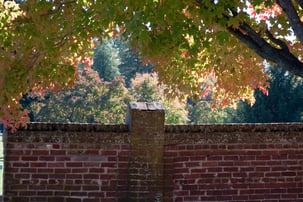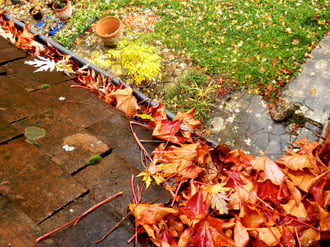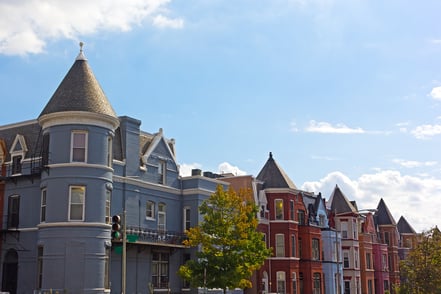 When the air starts to cool and leaves begin to scatter across Washington, D.C., you're likely to be focused on raking, cleaning gutters, and readying your landscaping for winter. What you may not be thinking about when you put together your fall home maintenance to-do list, though, is the brickwork holding up your historic home and garden walls. Autumn conditions like rain, temperature swings, and falling debris can all put a strain on masonry that has endured the heat and humidity of yet another summer in its long life. When you know how fall weather can affect old brick and mortar, you're better prepared to protect your historic investment before winter's chill sets in.
When the air starts to cool and leaves begin to scatter across Washington, D.C., you're likely to be focused on raking, cleaning gutters, and readying your landscaping for winter. What you may not be thinking about when you put together your fall home maintenance to-do list, though, is the brickwork holding up your historic home and garden walls. Autumn conditions like rain, temperature swings, and falling debris can all put a strain on masonry that has endured the heat and humidity of yet another summer in its long life. When you know how fall weather can affect old brick and mortar, you're better prepared to protect your historic investment before winter's chill sets in.
Why Fall Is a Critical Season for Masonry
Autumn brings a mix of weather that tests masonry in ways summer does not. Rains add moisture to small cracks, while cool nights and warmer days create expansion and contraction that strain mortar joints. Falling leaves and debris trap water against walls and foundations. For owners of historic homes, this season is a chance to spot problems early and take proactive steps to head them off. Repairs made in autumn also last longer and reduce the chance of costly emergency work once freezing temperatures arrive.
The Impact of Autumn Rains
Historic brick absorbs moisture more readily than modern materials, and autumn rains are often the trigger for visible deterioration. Water seeps into mortar joints or cracks in bricks, and once inside, it can stay there for weeks. Signs of water movement include white, chalky streaks known as efflorescence. If left unaddressed, that trapped moisture sets the stage for spalling and crumbling when winter freeze-thaw cycles begin.
Temperature Swings and Thermal Stress
 D.C. often sees warm afternoons followed by chilly nights in the fall. This daily shift causes masonry to expand and contract, a natural process that becomes more damaging when the mortar is already weak. Over time, small cracks open wider, and joints loosen. Homes built with lime-based mortar, common in older neighborhoods like Capitol Hill and Georgetown, are particularly vulnerable because the material is softer and more permeable. Without repairs, this seasonal stress compounds year after year.
D.C. often sees warm afternoons followed by chilly nights in the fall. This daily shift causes masonry to expand and contract, a natural process that becomes more damaging when the mortar is already weak. Over time, small cracks open wider, and joints loosen. Homes built with lime-based mortar, common in older neighborhoods like Capitol Hill and Georgetown, are particularly vulnerable because the material is softer and more permeable. Without repairs, this seasonal stress compounds year after year.
Falling Debris and Seasonal Buildup
 Autumn also brings a less obvious risk: organic debris. Leaves, twigs, and seeds that collect in gutters, at the base of walls, or on steps hold moisture against masonry surfaces. That moisture invites moss, mildew, and algae growth, all of which can slowly erode mortar. Clogged gutters or downspouts redirect water down walls, leading to staining, seepage, or deterioration at the foundation. Clearing debris regularly is one of the simplest ways to protect your masonry in the fall.
Autumn also brings a less obvious risk: organic debris. Leaves, twigs, and seeds that collect in gutters, at the base of walls, or on steps hold moisture against masonry surfaces. That moisture invites moss, mildew, and algae growth, all of which can slowly erode mortar. Clogged gutters or downspouts redirect water down walls, leading to staining, seepage, or deterioration at the foundation. Clearing debris regularly is one of the simplest ways to protect your masonry in the fall.
Preventative Care Tips for D.C. Homeowners
Taking a few simple steps in autumn can go a long way toward protecting historic masonry:
- Inspect mortar joints, walls, chimneys, and steps for cracks or missing mortar.
- Clear leaves and debris from gutters, downspouts, and the base of walls.
- Look for signs of efflorescence, staining, or spalling.
- Check for leaning or bulging areas in walls or retaining structures.
- Schedule professional help for any issues involving mortar matching or structural concerns.
Frequently Asked Questions
Does humidity in the fall affect historic brickwork? Yes. Damp conditions keep masonry wet for longer periods, which increases the risk of efflorescence and eventual freeze-thaw damage.
What is efflorescence, and is it serious? Efflorescence is a white, powdery residue left behind when water evaporates through brick. It signals that moisture is moving through masonry and should be investigated.
How often should I clean debris away from brick walls? At least once a week during peak leaf fall. Keeping masonry clear of organic buildup helps prevent moisture retention.
Do I need a permit for fall masonry repairs in D.C.'s historic districts? In many cases, yes. Visible exterior repairs often require approval and a permit to ensure they match the home's historic character.
Protect Your Masonry Before Winter Arrives
Autumn is a beautiful transitional season for the District, and it's also an excellent time to give your historic masonry the love and protection it needs. By inspecting, cleaning, and repairing now, you prevent water and weather from causing bigger problems in the months ahead. Renaissance Development has more than 20 years of experience restoring brick in Georgetown, Dupont Circle, Capitol Hill, and beyond.
Our expert team can help you identify issues early and carry out repairs that preserve both the strength and the character of your home. Arrange a complimentary consultation this fall.
Tags:
masonry restoration, masonry, maintaining historic brick, maintaining historic masonry DC, historic masonry DC, masonry repairs, weather damage to historic masonryOct 9, 2025 8:30:00 AM


